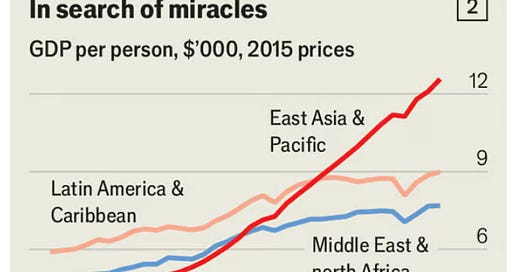

Discover more from The Pursuit of Happiness
AFAIK, all EC101 textbooks contain the following equation:
GDP = C + I + G + (X - M)
Not only does this equation exist in all textbooks (including the one I coauthored), it plays a prominent role. Here I’ll argue that this equation has negative value added. It adds essentially nothing to our students’ understanding of the macro economy, and actually confuses them on two key points. One part of the confusion is widely understood by economists, the other is not. And yet we refuse to do anything about the problem.
The equation measures total nominal gross domestic production, but does so in a very weird fashion. You’d think that an equation for total production would add up the production of various types of goods. This equation does not do that. Instead it starts by adding purchases of various types of goods, which is not at all the same thing as production. Then, as if realizing that a mistake had been made, it subtracts out purchases of goods that were not produced domestically (i.e., imports). It also adds in the production of goods produced domestically, but not purchased here (exports).
The way this equation is written, it leads to two sources of confusion, which I’ll call the “two myths”:
Many people wrongly assume that imports reduce GDP, because they appear in the equation with a minus sign.
Many people wrongly assume that if consumers become pessimistic and decide to spend less while saving more, this will cause GDP to fall. That’s because consumer spending appears in the equation with a positive sign.
Now to be clear, it is possible to write down plausible models where a decision to import more causes GDP to go down. And it is possible to write down plausible models where a decision to save more causes GDP to go down. I view these models as almost entirely useless, but some economists see them as having some validity.
But even if those models have some truth to them, the effects have absolutely nothing to do with the fact that C appears in the equation with a positive sign, and M appears in the equation with a negative sign. Nothing. Nada. In the unlikely event that these (Keynesian) models are true, they must be true for entirely different reasons.
Noah Smith has a very good post explaining the first myth, the idea that imports reduce GDP. He points out that while imports appear as a negative in the equation, they also show up as an equal positive, in the categories of either C or I (depending on whether the imported good is a consumer good like a car or an investment good like an airliner.)
The idea that consumers deciding to save more and spend less reduces GDP is also based on a fallacy. Recall that saving equals investment. Thus if consumers spend less and save more, then C will decline but I will increase. I hope you can see that these two fallacies are quite similar, as they both wrongly assume that an accounting equation shows causal effects.
Why doesn’t the GDP equation simply add up the production of various types of goods? That would make far more logical sense. I believe the expenditure equation was first developed as a technique for explaining the Keynesian model. Keynes himself believed that the two myths were actually true, or at least true in certain very important situations. So what I view as a source of confusion to students, he might have viewed as a source of enlightenment.
Why did Keynes believe that both fallacies were actually true, at least under certain conditions? Keynes understood everything that I’ve said so far, but he thought that if consumers spent less money on domestically built consumer goods, it would indirectly cause a decline in total nominal spending, also known as aggregate demand. (This is related to the famous paradox of thrift.)
This decline (if it occurs) has nothing to do with the accounting shown in the equation, rather it depends on a subtle and complex argument having to do with how changing consumer behavior might impact important economic variables such as the neutral interest rate. (And to translate a fall in demand into a fall in real output, you also need sticky wages/prices.)
For those familiar with the monetarist approach to macro, Keynes was basically saying that if consumers try to save more, or spend more on imports, it will reduce interest rates, and this will tend to depress velocity. And if the central bank refuses to cut interest rates in this case, then it will have to reduce the money supply. Either way, M*V will decline. I think that’s wrong, but it is not a crazy theory. Indeed lots of respected economists believe Keynes was right.
Before presenting my own view, let’s summarize where we are so far. Many average people believe that a decision by consumers to save more money, or to import more foreign goods, will hurt the economy. Saving more makes C go down, and importing more makes M go up. In both cases, GDP seems to fall. Both “man on the street” views are based on a misinterpretation of the equation. But Keynes argued that those sorts of spending actions actually could impact total nominal spending, through some subtle indirect effects that not one person in a thousand actually understands. So the man on the street might be right, but for the wrong reason.
Next I’ll describe why I believe both myths really are fallacies, and then end up by explaining why most economists are more sympathetic to one myth than the other.
Central banks try to target inflation (usually at 2%), by adjusting monetary policy in such a way as to allow moderate growth in aggregate demand. Whenever a shock hits the economy, they adjust their policy tools in a way that they believe is most likely to prevent any sort of undesirable shift in nominal spending. These adjustments are not always effective. Sometimes they over adjust and sometimes they under adjust their policy tool. The important point is that they adjust policy to a position where they expect stable NGDP growth.
This means that shocks to consumer behavior do not have significant effects on the expected path of nominal GDP, at least over the time frame where monetary policy is able to offset these shocks. And if policy is credible, the mere expectation of a future policy offset will tend to cause an immediate move in interest rates that largely offsets the shock. This doesn’t mean that the quantity of consumption or imports does not change; rather it means that any change that does occur will be offset by a change in another variable in the GDP equation.
Put simply, Keynes’s GDP = C + I + G + (X - M) equation does not explain the path of nominal GDP over time. That path is determined by monetary policy. Full stop.
So why do mainstream economists often disagree with a part of this analysis? Many economists accept the preceding analysis as a long run explanation, but do not believe it explains the short run. This leads them to accept my view of long run economic policy, but not short run policy.
Trade barriers such as tariffs are generally a long run policy. Thus economists accept that protectionist policies will not boost aggregate demand in a sustainable fashion, as the central bank will offset any effects. Similarly, increased saving is useful for the long run growth in the economy, because it helps to finance investment. The central bank can offset any drag on total spending.
Many economists worry, however, that a sudden decision by consumers to spend less on domestic goods will depress output in the short run, by reducing aggregate spending. They fear the Fed will not offset the effect of consumer pessimism or a trade deficit in a timely fashion. In my view, the Fed will make occasional mistakes, but it is equally likely to over-compensate for changes in consumer behavior as they are to under-compensate for such changes.
The baseline assumption should be that consumer shocks are expected to have no effect on nominal spending, but might have an effect in either direction if the central bank misjudges the situation. I hope you can see that we are now far from the naive model where variables like C and M directly impact GDP because they appear in the GDP equation.
If I’m wrong, if the central bank inevitably under-compensates for changes in consumer behavior, then there is an argument for activist policies. These would include fiscal policies to spur consumer spending and protectionist policies to discourage imports.
Interestingly, economists are far more likely to advocate the former than the latter. This reflects a series of political calculations. Protectionism might be hard to reverse after the recession is over. Foreign countries might retaliate. Most economists see fiscal stimulus as the more desirable option.
On the subject of fiscal policy, I disagree with mainstream economists. I believe they underestimate the extent to which macroeconomic “shocks” are actually just previous monetary policy errors. If monetary policymakers always set their tools at a position expected to deliver 4% NGDP growth, level targeting, then there is essentially no role for activist fiscal policy (and I am even more skeptical of activist trade policy.)
I wish textbooks did not include the GDP = C + I + G + (X - M) equation. I fear that it leads to negative knowledge. I wish that 90% of Macro 101 was classical economics where the economy is considered to be on the production possibilities curve, i.e., where more of one type of output means less of another type of output. I wish the other 10% of macro were business cycle theory where students were taught that occasional monetary policy mistakes lead to fluctuations in NGDP. And these NGDP fluctuations impact the labor market due to sticky nominal wages and impact the financial system due to nominal debt contracts.
K.I.S.S.
PS. Here I’ve mostly compared my views to those of respected mainstream economists. I should point out that there is a dark underworld often called “vulgar Keynesianism”, which sees too much saving and too many imports as not just a short run problem until corrected by the central bank, but as a long run chronic problem—sometimes termed “secular stagnation”. This once discredited theory made a bit of a comeback in the years after the 2008 crisis. I’ll let the reader decide which politicians are vulgar Keynesians.
PPS. This post focused on nominal GDP. Both international trade and saving can boost real GDP by making our economy more productive. If the Fed targets inflation rather than NGDP, that would lead to slightly higher NGDP growth as well.
PPPS. Publishers spend millions on textbooks. They don’t allow authors to deviate sharply from the standard approach. The problem is not the economists that write textbooks, it’s the economists that demand that the GDP = C + I + G + (X - M) equation be included in any book that they assign to their class.
Subscribe to The Pursuit of Happiness
Nostalgia for the Neoliberal Era















Notwistanding Matt Yglesias, Noah Smith, and now Scott Sumner, I rather doubt that the belief that exports expand and imports contract income is due the the Y = C + I + G + (X-M) equation. It's just the businessman's POV. They can sell their wares to consumers or investors or the government or foreigners and imports of what they are selling reduce their market. The businessman usually sees the economy aa demand constrained; it's the economist that sees production as constrained by resources and technology.
I have a couple of questions:
a) isn't it true that a reduction in imports has no effect on GDP only if you assume there's no substitution with domestically produced goods? A tarrif on European cars would reduce imports, but if consumers still spent the same amount on American cars, C wouldn't decrease, and GDP would go up, no?
b) S=I is true in the long run, but is it true in the short term? If people park more money in their bank, and their bank parks money at the Fed, how does that increase GDP?